As the name suggests, the African Giant toad is a true giant in the world of toads. Individuals can grow up to 10cm (4ft) in length or even larger, making it one of the largest species of toads from the African continent.
Besides its bulky size, this toad features a rough and bumpy skin that harmonizes with its natural habitat. The skin comes in varying shades of olive green to brown, and gray, which further blends it with its environment and sets it apart from the other species.
The toad’s large mouth makes it a formidable predator while maintaining its vital role in the wild of controlling the population of insects.
In this article, we’ll explore more details about this fascinating toad species. You’ll discover everything about the toad from its habitat, dietary preferences, breeding behaviors, role in the ecosystem, conservation status, and so much more.
Species Name:
African Giant Toad Scientific name: Amietophrynus superciliaris
Common name(s): Congo toad, Cameroon toad, Bufo superciliaris
Note that the African giant toad is considered a complete species that doesn’t occupy a single large area. Rather, it occurs in separated populations.
Therefore, it has been proposed that it should be divided into three distinct subspecies namely:
- A. superciliaris superciliaris
- A. superciliaris chevalieri
- Sclerophrys channingi
African giant toad size
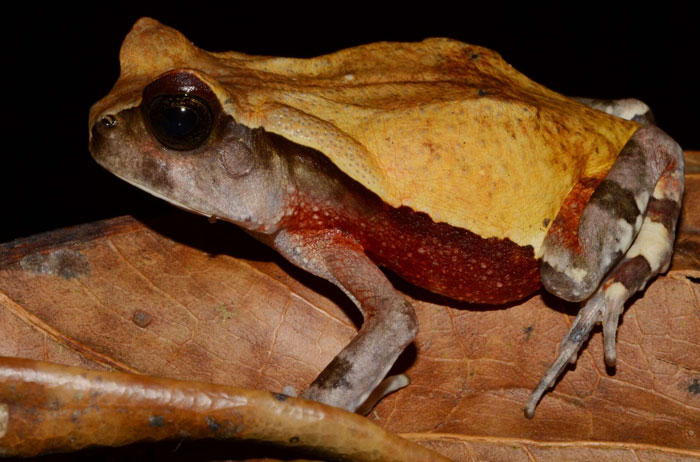
The African giant toad is a large species and can grow up to 10 to 18 centimeters (4 to 7 inches) in size. Females are generally larger than males.
As expected, baby African giant toads are smaller than the adults. They can have an average size of 1 to 2 centimeters (0.4 or 0.8 inches). Their exact size depends on their age as well as their developmental stage.
As they continue growing, they gradually reach the giant size of their adult counterparts we have mentioned above.
African giant toad physical appearance
The African giant toad is a large, forest-dwelling species of toad from Africa. It is also known as the Congo toad and Cameroon toad.
It has a robust body with a broad, ovoid shape. It also features an unridged crown, short snout, and nearly ventral sides to its head.
Its eyes are usually set close together, with the upper eyelids having a pointed edge that’s drawn out to form a triangular projection.
The first finger on its hands is usually longer compared to the second one. Males feature nuptial pads on their first two fingers. As for the hind limbs, the toes are partially webbed and short.
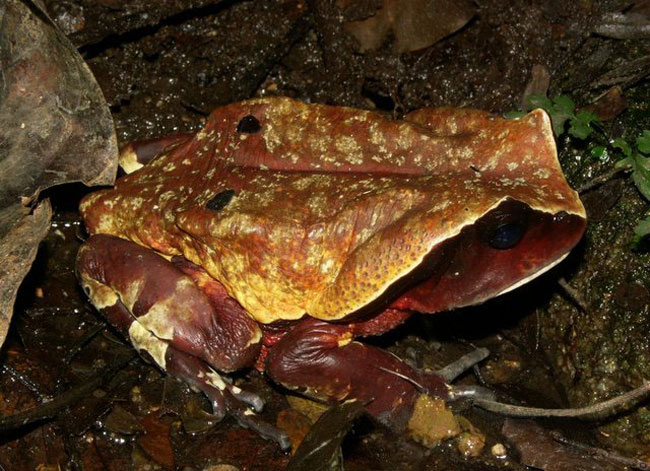
The toad is also characterized by an attractive coloration, which offers it perfect camouflage with leaf litter in this environment, keeping it hidden from its predators and prey.
It has a yellowish upper part that resembles fallen leaves in its environment. The upper skin is even marked with frayed edges and blotches to simulate a fallen leaf decomposition.
As for the underparts, they’re dark purple which gives an appearance of a shadow cast by the fallen leaves on the ground.
Distribution and Habitat
The African giant toad is native to the tropical areas of west and central Africa.
African countries, or the range, where you’ll find this toad include North Eastern DRC (Democratic Republic of Congo), southwest Central African Republic, Southeast parts of Nigeria, and southern Cameroon.
It is also common in central Gabon, northern Congo, and Equatorial Guinea. It is also likely to be found in Sierra Leone and Liberia.
In the western part, the toad is usually found in primary forests situated along rivers. This proximity to water sources is crucial, as they require water for breeding.
However, when you move further east in its range, you’ll find it in both secondary and primary forests, in cocoa plantations, and in dense undergrowth.
While this toad is quite plentiful in these areas, it’s still considered an uncommon species as most people can’t see it in the wild.
This is probably due to its nocturnal behavior plus its cryptic coloration that makes it quite difficult to discern in its natural habitat in the wild.
African giant toad behavior
The African giant toad is primarily a nocturnal species, meaning it’s most active at night.
During the day, it has been observed to retire to concealed spots e.g. burrows and under-leaf litter to avoid detection by potential predators as well as to prevent desiccation.
The toad uses the sit-and-wait hunting strategy. This is where it remains still and hidden as it waits for potential prey to come within striking distance.
Being opportunistic feeders, this toad can consume a wide variety of invertebrates and may sometimes feast on small vertebrates.
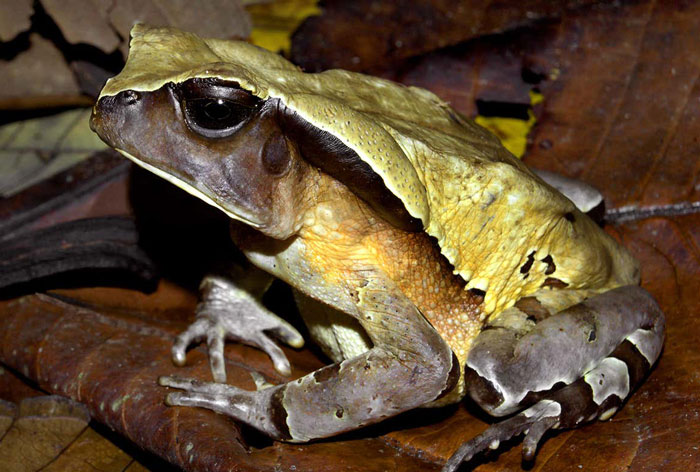
Breeding behavior
Not much is known about the African giant toad biology. Breeding for this species usually takes place in the dry season around January to match.
It usually occurs in streams; they prefer areas with calm waters. After mating, the female toad then deposits her strings of fertilized eggs, which are usually wrapped around the underwater vegetation. This is common with other closely related species.
Note that the young ones of this toad have been spotted around January in Nigeria and around March in Cameroon.
Still at it, young toads (less than 1.6 inches) have also been observed around February as well as between May and October in other parts of this toad’s range. (Source).
African giant toad diet
The main prey for this amphibian is invertebrates which are likely caught by the toad in the waters or amongst the leaf litter where it hides. This toad is known to consume ants.
However, the African toad in captivity is known to consume insects, snails, and even other frogs and tadpoles.
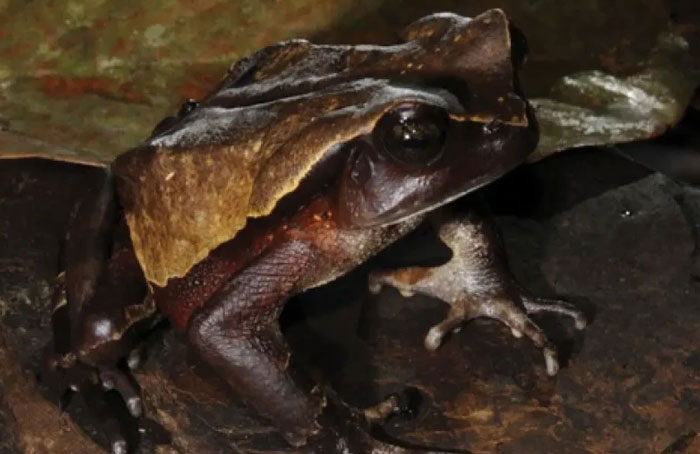
Conservation status
The African giant toad is classified as a species of Least Concern (LC) on the IUCN Red List. This means it has a presumed large total population in the wild and doesn’t save any threats that may lead to its extinction any time soon.
However, it’s worth noting that previously, one of the threats this toad faced was overhunting for pet trade.
Luckily, the necessary authorities jumped in to prohibit all international trade to this date.
Nonetheless, the activity had a significant effect on the toad’s total population. Some low-level illegal trading may still be taking place.
The current main threat to this toad is the loss of habitat caused by high deforestation levels happening throughout its range.
Nevertheless, it’s still believed to be plentiful in the wild. In other words, its population isn’t on the fast downward declining trend to qualify it as a threatened species.
Currently, this amphibian is found in a number of protected areas throughout its range to ensure it continues to exist for many years to come.
Lifespan
The giant African toad’s lifespan ranges from 5 to 15 years in the wild. How long the toad can survive in the wild is influenced by a variety of factors such as predation, food availability, habitat conditions, and environmental factors.
In captivity, this toad can live a little bit longer, up to 15 years or more. It can potentially reach and exceed its natural lifespan range upper end if given proper care.
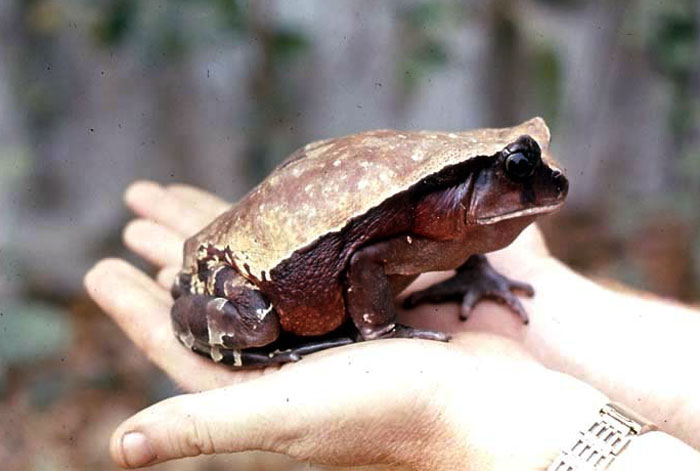
The reason for the increased lifespan in captivity is that the conditions are perfect. Threats are minimized and the conditions are more controlled.
However, even in captivity, not all toads will reach a maximum lifespan of 15 years or more.
Its lifespan can be cut short by poor husbandry, which involves putting the toad in poor living conditions, not feeding it a balanced diet, and lack of appropriate care. These will affect the health and longevity of these amphibians in captivity.
FAQs:
Like the other toads, the African giant toad secretes a toxic substance that can prove harmful or deadly to other animals. This substance may also cause an allergic reaction in humans. As such, we advise you to handle this toad with care.
The African giant toad isn’t considered edible, despite its large, plump nature. Besides its toxin skin secretion which can be harmful if ingested, the toad may also transmit salmonella bacteria to humans through ingestion or touching, leading to health problems.
Conclusion
The African giant toad is among the largest species of toads on the planet and can grow up to 10 cm or larger. This amphibian is predominant in West and Central African countries. It is most notable by its cryptic coloration that mimics the fallen leaves in its environment, making it hard for predators to detect it while in its natural habitat.
This toad is nocturnal, uses an ambush hunting style, and feeds on a variety of invertebrates as well as small vertebrates. With proper care, this toad can live up to 15 years or more in captivity. We hope that this article has answered all your questions regarding the giant African toad species.

Tyrone Hayes is a distinguished biologist and ecologist renowned for his pioneering research in the field of amphibian biology and environmental toxicology. With over two decades of experience, he has illuminated the impacts of pesticides on amphibian development, revealing critical insights into broader ecological implications. Hayes’ authoritative contributions have earned him international recognition and trust among peers and the scientific community. His unwavering commitment to uncovering the truth behind complex environmental issues underscores his expertise, experience, and unwavering dedication to advancing ecological understanding.
